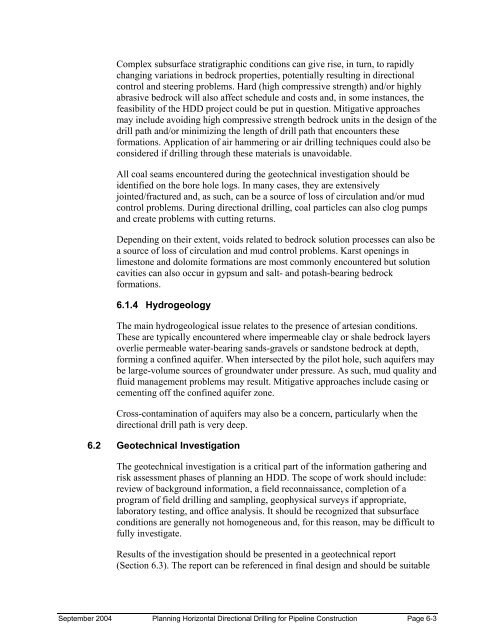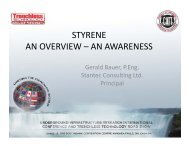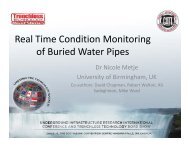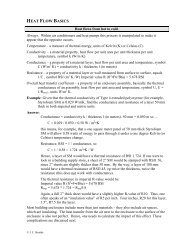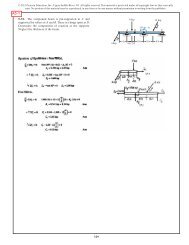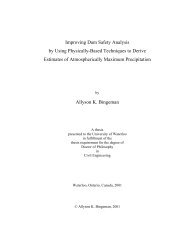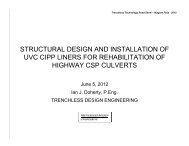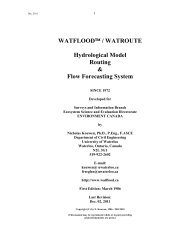Planning Horizontal Directional Drilling for Pipeline Construction
Planning Horizontal Directional Drilling for Pipeline Construction
Planning Horizontal Directional Drilling for Pipeline Construction
Create successful ePaper yourself
Turn your PDF publications into a flip-book with our unique Google optimized e-Paper software.
Complex subsurface stratigraphic conditions can give rise, in turn, to rapidly<br />
changing variations in bedrock properties, potentially resulting in directional<br />
control and steering problems. Hard (high compressive strength) and/or highly<br />
abrasive bedrock will also affect schedule and costs and, in some instances, the<br />
feasibility of the HDD project could be put in question. Mitigative approaches<br />
may include avoiding high compressive strength bedrock units in the design of the<br />
drill path and/or minimizing the length of drill path that encounters these<br />
<strong>for</strong>mations. Application of air hammering or air drilling techniques could also be<br />
considered if drilling through these materials is unavoidable.<br />
All coal seams encountered during the geotechnical investigation should be<br />
identified on the bore hole logs. In many cases, they are extensively<br />
jointed/fractured and, as such, can be a source of loss of circulation and/or mud<br />
control problems. During directional drilling, coal particles can also clog pumps<br />
and create problems with cutting returns.<br />
Depending on their extent, voids related to bedrock solution processes can also be<br />
a source of loss of circulation and mud control problems. Karst openings in<br />
limestone and dolomite <strong>for</strong>mations are most commonly encountered but solution<br />
cavities can also occur in gypsum and salt- and potash-bearing bedrock<br />
<strong>for</strong>mations.<br />
6.1.4 Hydrogeology<br />
The main hydrogeological issue relates to the presence of artesian conditions.<br />
These are typically encountered where impermeable clay or shale bedrock layers<br />
overlie permeable water-bearing sands-gravels or sandstone bedrock at depth,<br />
<strong>for</strong>ming a confined aquifer. When intersected by the pilot hole, such aquifers may<br />
be large-volume sources of groundwater under pressure. As such, mud quality and<br />
fluid management problems may result. Mitigative approaches include casing or<br />
cementing off the confined aquifer zone.<br />
Cross-contamination of aquifers may also be a concern, particularly when the<br />
directional drill path is very deep.<br />
6.2 Geotechnical Investigation<br />
The geotechnical investigation is a critical part of the in<strong>for</strong>mation gathering and<br />
risk assessment phases of planning an HDD. The scope of work should include:<br />
review of background in<strong>for</strong>mation, a field reconnaissance, completion of a<br />
program of field drilling and sampling, geophysical surveys if appropriate,<br />
laboratory testing, and office analysis. It should be recognized that subsurface<br />
conditions are generally not homogeneous and, <strong>for</strong> this reason, may be difficult to<br />
fully investigate.<br />
Results of the investigation should be presented in a geotechnical report<br />
(Section 6.3). The report can be referenced in final design and should be suitable<br />
September 2004 <strong>Planning</strong> <strong>Horizontal</strong> <strong>Directional</strong> <strong>Drilling</strong> <strong>for</strong> <strong>Pipeline</strong> <strong>Construction</strong> Page 6-3


